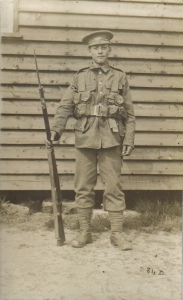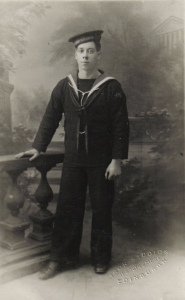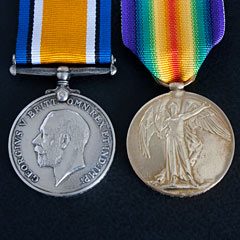Able Seaman Leonard Maltby Hasman
Tyneside Z/7174, Anson Bn. R.N. Div., Royal Naval Volunteer Reserve
who died on 13th November 1916, aged 18
Remembered with Honour
Barrow Hill Memorial
Staveley Parish Memorial
Ancre British Cemetery (Plot 16 F3)
Elijah and Hannah Hasman (nee Maltby) began married life at Birley Cottage in Brampton where Elijah worked as a farm labourer. Hannah was originally from Eyam but Elijah, their son Charles William and their two young daughters, Emily and Hannah Elizabeth, were all born in Brampton.
By 1901, the family had moved to Barlow where sons George Arthur and John James were born and then to 52, Boythorpe Lane where the family grew with the births of Alice Ann, LEONARD and Henry. Hannah Elizabeth was living with her mother’s relatives in Great Hucklow.
Following the births of Herbert, Mary Jane and Hilda, the family moved to live at 53, Devonshire Cottages, Barrow Hill. “The Devonshire” consisted of 8 blocks of 11 cottages in two rows built for employees of the Staveley Coal and Iron Company overlooking the Devonshire Works. Elijah and Charles worked as furnace labourers whilst John and George were employed at the foundry
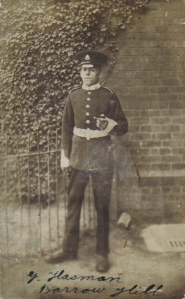 George Arthur Hasman (11948) was in the regular army and was serving with the 2nd Bn., Sherwood Foresters (Notts and Derbys Regiment) in the 6th Division when war was declared. This peacetime Division of the pre-war army was quartered in Ireland and England at the outbreak of war, and was ordered, on mobilisation, to concentrate near Cambridge. By early September it was fully equipped and trained.
George Arthur Hasman (11948) was in the regular army and was serving with the 2nd Bn., Sherwood Foresters (Notts and Derbys Regiment) in the 6th Division when war was declared. This peacetime Division of the pre-war army was quartered in Ireland and England at the outbreak of war, and was ordered, on mobilisation, to concentrate near Cambridge. By early September it was fully equipped and trained.
On the 10 September 1914 George landed with the battalion at St Nazaire and proceeded to the Western Front. The 2nd Battalion was part of the British Expeditionary Force and went straight into the bitter fighting on the Aisne. They fought another major battle in October at Ennettiere on the way to Ypres, holding a vastly superior German force for 48 hours and losing in the process 16 officers and 710 other ranks.
George was discharged from the army on 6th September 1916 and the Silver War badge issued to him indicates that he was honourably discharged due to wounds or sickness. He was also awarded the British War Medal, the Victory Medal and the 1914 Star with clasp and roses.
 John James Hasman enlisted at Staveley on the 2nd February 1915 aged 21 years and was posted to the Machine Gun Section, 9th (Service) Bn.,Sherwood Foresters (Notts and Derbys Regiment).
John James Hasman enlisted at Staveley on the 2nd February 1915 aged 21 years and was posted to the Machine Gun Section, 9th (Service) Bn.,Sherwood Foresters (Notts and Derbys Regiment).
He arrived to join the battalion at Gallipoli on 28th August 1915 and was evacuated with them to Egypt in December. He was then posted to France on 28th June 1916 and fought on the Somme before being wounded on 29th November 1916. According to a comrade, “He was a hero through it all and never grumbled when he got hit. He caused no-one any trouble and made light of the wounds.”
John James was treated in the field and posted back to England on 28th December 1916 before being discharged in October 1917 as no longer fit for active service. Like older brother George, he was also issued with a silver war badge.
LEONARD MALTBY HASMAN was born on 26th February 1898 and was just 16 years old when war was declared. He was working at the “Old Works” but “war fever was too strong for him (and) he enlisted to do his bit in the R.N.D. at the Recruiting Office at New Whittington” on August 24th 1915, along with his younger brother Henry who was discharged when his age was discovered . Leonard gave his date of birth as 26th February 1897 when he was, in fact, a year younger at just 17.
By the end of the 63rd (Royal Naval) Division’s part in the Gallipoli campaign, very few men with sea service remained. The Division had transferred from the authority of the Admiralty to the War Office on 29 April 1916 and was re-designated as the 63rd (Royal Naval) Division on 19 July 1916. The Division moved to France, arriving at Marseilles 12-23 May 1916, after which it remained on the Western Front.
Leonard went to France in July 1916 and was posted to Anson Battalion from the Base depot at Etaples on 21st August 1916. He had been on active service for only 4 months when the 63rd (Royal Naval) Division took part in the Battle of the Ancre on 13th November 1916.
The assembly of the troops began on the 12th November and was complete by 2030hrs. The communications trenches and front line had been shelled quite heavily by the enemy hoping to get lucky and the brigade suffered 70 casualties as a result of this probing shellfire. The operational order stated that the troops should be ready by 04:45 due to the fact that the trenches were under observation from the Thiepval ridge, bayonets were to be fixed in the dark as the sun catching hundreds of bayonets would give the game away.
The attack went in at 05:45. The weather was very misty obscuring the field of view. Each battalion went over in 4 waves as all four of the brigades battalions advanced. Within minutes of the opening barrage the Germans replied with artillery fire on no man’s land and the support trenches. The land sloped down to the German trenches and as feared was terribly muddy and shell pocked which hindered fast progress. The Germans were also sweeping no man’s land with machine gun fire.
By 0630 the two leading battalions had taken the German first two lines. Although the first two lines had been over-run, there were many Germans holding out in dugouts and as they emerged they sniped at the attackers from behind. Severe hand to hand fighting ensued with bombing, bayonets, fists and boots. Bomb blocks were set up in these trenches; obstructions thrown up inside the trench like barricades. The Germans left in these trenches were being pushed southwards.
The original plan for specific battalions to take certain lines had now gone; 1RM and 2RM were mixed, Anson and Howe were mixed and there were various groups of isolated men. At 09:30 the order came for another push, a short barrage was started and the attack started with every available man advancing. There were many attempts to advance in the next two hours, but the third German line near the strongpoint was still not completely taken, much of it was occupied and there were some who made it to the line, about 200 men of mixed units.
By 12:30 much of the third line that had been captured had to be abandoned as it was being barraged by “friendly” artillery and the units had to pull back to the German second line for shelter. An entry in the brigade war diary at 12:20 stated an intense barrage was to be opened on the German third line and all troops were to assault at the end of it. This entry coincides with an entry in Anson’s diary that their men were shelled out of this trench by their own artillery. Source
Leonard Hasman was killed in action on the first day of the Battle of the Ancre at Beaumont Hamel. He was 18 years old, a year younger than the age limit for service abroad, and had only been on active service for four months. He was initially listed as missing and his family had to wait until July 1917 before they received official confirmation that he had been killed on November 13th. This must have been an anxious time for his parents, especially with their other son John James having been wounded around the same time.
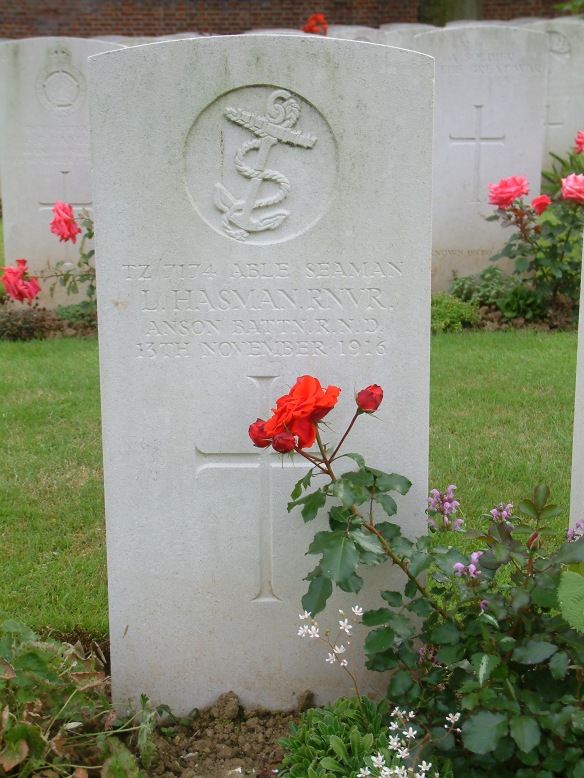 Leonard Hasman is buried in Plot 16 F3 of the Ancre British Cemetery alongside many of his comrades who were killed on the same day.
Leonard Hasman is buried in Plot 16 F3 of the Ancre British Cemetery alongside many of his comrades who were killed on the same day.
*John James Hasman married Louisa Longstaff in 1918. When their son was born in 1921, he named him Leonard after his younger brother. The name of this Leonard Hasman (1921-1940) is also inscribed on the war memorial at Barrow Hill with others killed during WW2.
©Ann Lucas

